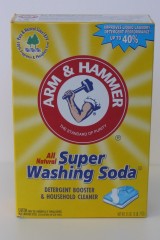
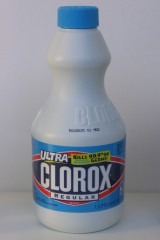
Some of the required reagents.
Aggie Curse
Summary
The Aggies of Texas A&M University are a rival to the Longhorns of the University of Texas. Since the Longhorns compete with the Aggies so often (e.g. in sports) it is helpful to destroy any lurking spirits of Aggies that lurk nearby. If you attend any sporting event in Austin, TX, between the Texas Longhorns and the Texas A&M Aggies, you will likely see hordes maroon-clad fans, coming out of the woodwork. Clearly, there are plenty of Aggie spirits around here. (After all, who would want to live in College Station?) This experiment is a 'magic' trick to, first trap these lurking Aggie sprits, and then to destroy them, thus making the world safe for decent humankind.
The demonstration starts with five different clear, colorless solutions. One of these is poured into a large container. Next, two of the colorless solutions are mixed to form a white mixture. This white mixture is poured into the large container, which suddenly turns red-purple. Next, the two remaining colorless solutions are mixed, resulting in a black mixture. This black mixture is poured into the container with the colored mixture. Fizzing and bubbling results, and the black, white and color all disappear, resulting in a clear, colorless solution.
Required Reagents
5% White vinegar
2% Iodine tincture
Vitamin C (ascorbic acid), powder or tablets
Concentrated laundry starch
Washing soda
Epsom salt
1%
phenolphthalein solution
1%
thymolphthalein solution
Rubbing alcohol
Distilled water


Some of the required reagents.
Stock Solutions
First, prepare the following stock solutions. In general, the total amount of the solution is not critical, the main thing is to prepare the correct percentage (by weight) solution. It is important to measure solids by weight, not volume. Once you have prepared the diluted stock solutions, you can chose to measure these out by volume if you like. For everything except the iodine tincture, 1.0 g equals 1.0 mL. Since 1 teaspoon equals about 5.0 mL and 1 tablespoon equals about 15.0 mL, you can easily convert the amounts to use into teaspoons and tablespoons, if you like.
Vinegar
Purchase some 5% white vinegar from the grocery store. I bought mine from the HEB in Austin, TX. Make sure to use colorless vinegar.
Iodine
Purchase some 2% iodine tincture from the grocery store. I bought mine from the HEB in Austin, TX. Make sure to use 2% iodine tincture, which contains 2% iodine and 2.4% sodium iodide. There are other things with similar names available, e.g. "colorless tincture of iodide", these are not suitable. Tincture of iodine is flammable and poisonous. It may be a good idea to wear gloves when pouring it to avoid getting brown iodine stains on your fingers. You may be able to remove any iodine stains with vitamin C solution.
Vitamin C
Ascorbic Acid Stock Solution (0.1 mol/kg):
1.0 g of ascorbic acid (vitamin C)
60.0 g of distilled water
Pure vitamin C powder is pretty easy to find, at health food stores and some grocery stores, but you can also use vitamin C tablets, containing a total of 1000 mg. If you use tablets, mash them up completely in the water, to dissolve them as much as possible. Many tablets will contain some insoluble materials that will not dissolve. You can filter these off if you like, but this should not be necessary. Avoid using "flavored" or "chewable" tablets, which may contain additional ingredients which could interfere with the reaction. This solution does not keep well, so it needs to be prepared fresh.
Optional: 5% Sodium Thiosulfate Stock Solution (0.2
mol/kg):
2.5 g of sodium thiosulfate 5-hydrate (pentahydrate)
47.5 g of water
A 5% sodium thiosulfate solution can be used, weight for weight, as a replacement for the ascorbic acid solution. Thiosulfate solutions keep much better than ascorbic acid solutions (although they do go bad eventually), so you can make up a stock solution of this and keep it for months, which is much more convenient. Ascorbic acid, even carefully stored, goes bad within days. (It even starts to brown a little bit during this experiment.) You do need to get sodium thiosulfate from a chemical supplier, but it is easy to find (even for individuals), cheap, and non-toxic.
Starch
25% Starch Stock Solution:
10.0 g of concentrated laundry starch
30.0 g of water
The concentration of the starch solution is not critical. Stir the mixture well, the starch is very viscous and needs stirring to mix well. The result is a somewhat cloudy solution. I bought "Faultless" brand concentrated liquid starch at the HEB in Austin, TX.
Optional: If laundry starch is unavailable, an alternative can be prepared by mixing 5 grams of cornstarch with 30 mL of cold water until a thin suspension is formed. Pour the suspension slowly into 500 mL of vigorously boiling water with stirring so that the boiling does not stop. Allow it to cool before use.
Sodium Carbonate
20% Sodium Carbonate 10-Hydrate Stock Solution (0.7 mol/kg):
10.0 g of washing soda (sodium carbonate 10-hydrate)
40.0 g of water
Sodium carbonate can be found in the grocery store as "washing soda". I bought "Arm & Hammer" brand "Super Washing Soda" at the HEB in Austin, TX. This resulted in a slightly cloudy solution that smelled a little soapy. The soapy stuff is impurities, pure sodium carbonate does not smell like this. The soapiness didn't seem to cause any problem in the experiment, however. This form of sodium carbonate has 10 molecules of water in the crystal structure, per molecule of sodium carbonate. Sodium carbonate is a moderately strong base, and will probably irritate the skin and will definitely irritate the eyes.
Optional: 9% Sodium Carbonate Monohydrate Stock Solution
(0.7 mol/kg):
4.5 g of sodium carbonate 1-hydrate (monohydrate)
45.5 g of water
If you have any access to a chemical supplier, sodium carbonate 1-hydrate (monohydrate) is easy to find and cheap. This form of sodium carbonate keeps better than the washing soda form, and so this is preferred if you have it. This should also be more pure than the grocery store stuff. Sodium carbonate is one of many chemicals that comes in different "hydrate" versions. All of these types are basically the same chemical, sodium carbonate, but they have different amounts of water locked up in the crystal structure. Since they are really the same, you can use any of them, but the weight used needs to be adjusted to account for the different amount of water in the crystal. This is why the 10-hydrate is prepared as a 20% solution, while the 1-hydrate is prepared as a 9% solution.
Magnesium Sulfate
10% Magnesium Sulfate 7-Hydrate Stock Solution (0.4 mol/kg):
5.0 g of Epsom salt (magnesium sulfate 7-hydrate)
45.0 g of water
Magnesium sulfate can be found at the grocery store, or drugstore, as "Epsom salt". It is supposedly good for healing sore feet, which is something I need to try some day.
Bleach
25% Bleach Stock Solution:
10.0 g of 6% sodium hypochlorite bleach
30.0 g of water
I bought "Ultra Clorox" brand regular bleach at the HEB in Austin, TX. Avoid using bleach with added perfumes or other stuff, which might interfere with the reaction. Usually, the cheaper stuff is best for chemistry. You should be able to use 5.25% bleach as well. Ideally, you should increase the amount of bleach used to compensate, but this demonstration is forgiving enough that it should work even without changes.
Warning - Do not add straight bleach directly to vinegar, or perform this demonstration with much larger amounts of bleach solution than specified. A hazardous reaction may occur. (Small variations in the amount used, such as those made by imprecise measurements, should not create any hazard.)
Alcohol
Purchase some 91% isopropyl alcohol ("rubbing alcohol") from the grocery store. I bought mine from the HEB in Austin, TX. The 70% strength should also work fine, as should vodka or a similar concoction. Isopropyl alcohol is flammable.
Indicator
Aggie-Indicator -
8.0 g of 1% phenolphthalein solution
3.0 g of 1% thymolphthalein solution
This will also result in a clear, colorless solution. Varying the amounts of phenolphthalein and thymolphthalein will change the color that will be produced during the experiment. All phenolphthalein will result in a pink-magenta color, while all thymolphthalein will result in a blue color, and mixtures will result in a color somewhere in between. I chose the amounts to get the best match to Aggie maroon that I could.
Hazard - Phenolphthalein is a suspected carcinogen. In the quantities used in this experiment, this risk is probably quite small. (It used to be used as a laxative.) However, you should handle this material with care, and avoid getting it on your skin, and especially avoid ingesting any. Thymolphthalein is not known as a cancer risk, but should be handled with the same care as phenolphthalein.
http://www.jtbaker.com/msds/englishhtml/p2015.htm - MSDS for phenolphthalein
http://www.jtbaker.com/msds/englishhtml/t3367.htm - MSDS for thymolphthalein
Optional - Other Indicators:
The indicators are the most difficult chemicals to find. You won't find them at grocery stores, so you will need to find a chemical supplier. See the Home Chemistry section below for some hints. Phenolphthalein is fairly easy to find, while thymolphthalein is less common. You can do the demonstration with just phenolphthalein, if you like, with just thymolphthalein, or with different ratios of the two than specified. (Changing these will change the color that you get.)
I like to buy the indicators as powders and mix up my own solution in alcohol, but pre-made 1% solutions are common.
Even if you can't find any indicators at all, you can still do this demonstration, omitting them. It won't have a color change, but you will have the effect of combining clear solutions to make both white and black, and combining these to make a clear, colorless solution.
Optional - Research Project:
The 8:3 ratio of phenolphthalein to thymolphthalein is chosen to make a color that is as close to Aggie maroon as possible. It isn't as close as I would like, which probably means that the Aggies are able to partially evade this curse. Some interesting indicators to try would be o-cresolphthalein (which changes from colorless to red), and m-nitrophenol (which changes from colorless to yellow).
Preparation
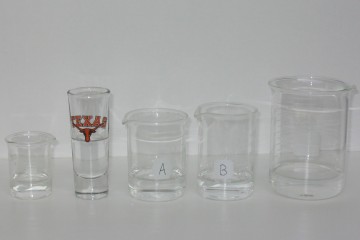
The solutions. From left to right, Aggie, Longhorn, Solution A, Solution B
and Solution C.
Next, prepare the following solutions. Since 1 teaspoon equals about 5.0 mL and 1 tablespoon equals about 15.0 mL, you can convert the amounts to use into teaspoons and tablespoons, if you like.
Aggie Solution:
25 drops of Indicator Stock solution (around 0.5 g)
12.0 g (15.0 mL) of Alcohol
Pour this clear, colorless, mixture into an Aggie-themed shot glass, which serves as a small beaker. The amount of alcohol is not critical.
Longhorn Solution:
5.0 g of Bleach Stock solution
15.0 g of water
Pour this clear, colorless, mixture into a Texas Longhorn-themed shot glass, which serves as a small beaker. Don't use much more bleach than specified. The amount of water is not critical.
Solution A:
10.0 g of Sodium Carbonate Stock solution
5.0 g of Vitamin C Stock solution
25.0 g of water
This will result in a clear, colorless solution.
Solution B:
10.0 g of magnesium sulfate stock solution
25.0 g of water
This will also result in a clear, colorless solution.
Solution C:
1.8 g (2 mL) of Iodine Stock solution
60.0 g of Vinegar
Enough Vitamin C Stock solution to clear all brown color (see below)
2.5 g of Starch Stock solution
After combining the iodine and vinegar, you will have a brown colored solution. Add just enough Vitamin C solution to this, with stirring or swirling, to make the brown color entirely disappear. (It should take around 30-35 drops.) Don't use too much Vitamin C. I like to add it by drop until it seems like it has turned completely colorless, then I add one more drop. After this, add the starch solution. The result is a clear, colorless solution, possibly very slightly cloudy due to the starch. If this tries to turn dark blue, add additional drops of Vitamin C solution until it turns colorless.
Demonstration
You should have five different clear, colorless solutions, two in shot glasses, and three in various other containers.
The first step is to prepare the Aggie Solution to trap the evil Aggie spirits. Point the magic wand at the Aggie solution, and utter some magic incantations. "I don't live in College Station, I don't live in College Station, I don't live in College Station." Then pour the Aggie solution into a large container (e.g. 600 mL beaker.)
Pour Solution A and Solution B into a separate container, e.g. a 150 mL beaker, and stir or swirl to mix. Over a few seconds, this will turn white, as a solid precipitate is formed. (If you let the white mixture sit, the precipitate may settle to the bottom, leaving a clear layer on top. If this happens, just mix it up again.)
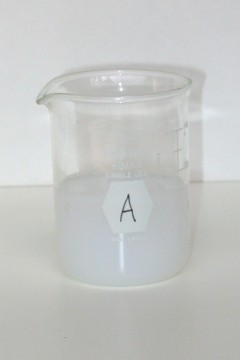
The white mixture.
This white mixture is now the "trap" that will capture the evil spirits. Pour the white mixture into the large container that you poured the Aggie solution into. The mixture will change to red-purple, approximately the color of Aggie maroon. (The white precipitate will remain, so you will have a colored, cloudy, mixture.)
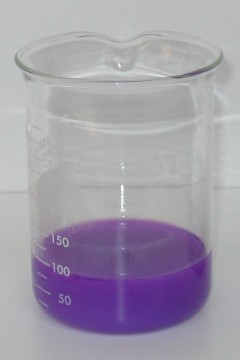
After the white mixture is added to the Aggie solution.
The color match isn't as close as I would like, which probably means that the Aggies are able to partially evade this curse. I hope to do some additional alchemical research to make a more accurate color match.
Now you need to prepare the Longhorn Solution to summon the negative material energy that will destroy the trapped Aggie spirits. Point the magic wand at the Longhorn solution, and utter a second set of magic incantations. "Send them back to College Station, Send them back to College Station, Send them back to College Station." Pour the Longhorn Solution into a new separate container, then pour Solution C into this, and swirl or stir to mix. The mixture will turn black. (Actually, very dark blue.)

The black mixture.
Pour the black mixture into the large container with the colored mixture, and stir or swirl to mix. The new mixture will fizz, and the black, white, and maroon colors will all disappear, resulting in a clear, colorless solution. (If you stir this more vigorously, you will get more bubbling and fizzing. Stirring also helps to dissipate any of the colors that are stubbornly remaining.)
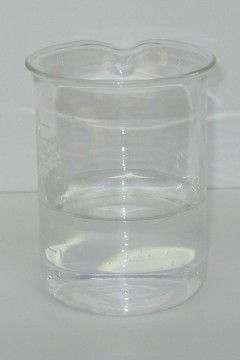
The clear solution, after destroying the evil spirits.
The Aggie spirits have been destroyed!
Hazards
Do not mix bleach directly with vinegar, except in the amounts, and according to the procedures, described. Mixtures of bleach and acids can form poisonous gasses. Phenolphthalein (and possibly thymolphthalein) may be carcinogenic in sufficiently large doses.
Disposal
The resulting clear, colorless solution can be poured down the drain with water. Any excess black solution should be neutralized with Vitamin C solution until it is colorless, then poured down the drain with water. Any excess white precipitate or colored solution should be reacted with vinegar until it is clear and colorless, then poured down the drain with water. Any other solutions can be poured down the drain with water.
Explanation
When the sodium carbonate solution is prepared, some of the carbonate ions react with water, according to reaction 1, forming hydroxide ions, which makes the solution basic.
CO32- + 2H2O <---> H2CO3 +
2OH- [reaction 1]
H2CO3 <---> CO2 (gas) + H2O
[reaction 2]
When the magnesium sulfate solution is added to the carbonate solution, magnesium ion reacts with the hydroxide ion to form white, insoluble magnesium hydroxide, according to reaction 3. As the solid precipitates, removing it from the reaction, the equilibrium is driven to the right.
Mg2+ + 2OH- <---> Mg(OH)2 (solid) [reaction 3]
These reactants are then added to the Aggie solution. The Aggie solution contains two indicators (phenolphthalein and thymolphthalein) which are colorless in acid or neutral conditions, but which will change color, to pink and blue, respectively, in basic conditions. They are dissolved in alcohol, which is approximately neutral, in which they are more soluble than in water. The basic conditions cause the indicators to change color, to red-purple which approximates Aggie maroon.
When Solution C is being prepared, it at first contains iodine, which causes the brown color. As the ascorbic acid is added to this, the iodine is reduced to colorless iodide ion, according to reaction 4-A. Just enough ascorbic acid is added to reduce all the iodine to iodide ion, so solution C then contains only iodide ion. If thiosulfate is used instead of ascorbic acid, then reaction 4-B applies instead of 4-A. Note that twice as many molecules of thiosulfate are required, compared to ascorbic acid.
I2 + C6H8O6
-> 2H+ + 2I- + C6H6O6
[reaction 4-A]
I2 + 2S2O32- -> 2I- + S4O62-
[reaction 4-B]
When the Longhorn solution is mixed with Solution C, hypochlorite ion in the bleach oxidizes iodide ion back to iodine, according to reaction 5. The iodine, in the presence of iodide ion, forms a very dark blue (almost black) complex with starch, resulting in the black color.
2I- + OCl- + 2H+ <---> I2 + Cl- + H2O [reaction 5]
When the black liquid is added to the colored liquid containing the magnesium hydroxide precipitate, the excess acid from Solution C results in a very low concentration of hydroxide ions, and so reaction 3 shifts to the left, dissolving the precipitate, while reactions 1 and 2 shift to the right, forming carbon dioxide gas which bubbles off. Also, the indicators change back to their colorless forms in the acidic conditions. At the same time, the ascorbic acid from Solution A reduces the iodine from Solution C to iodide ion, according to reactions 4. Iodide ion does not form the black complex with starch, and so the black color disappears.
What is left is a clear, colorless solution, with bubbles in it.
For all this to work, it is necessary that Solution C contains enough acid to dissolve the magnesium hydroxide precipitate, and that Solution A contains enough ascorbic acid to reduce the iodine formed by the hypochlorite bleach. If not all of the changes happen correctly, this may point to the ingredient that is present in either insufficient or excessive amounts.
Home Chemistry
The large chemical suppliers (e.g. Aldrich) will not sell anything to individuals at all, so finding chemicals as a hobbyist requires a little resourcefulness. It is not that difficult, however, at least in the USA. Some smaller suppliers will sell to individuals, and some suppliers specialize in photographic chemicals for hobbyists, and some aim to supply home school science supplies. It is also possible to find many chemicals on eBay. You can also find lab glassware (beakers, etc.) from these sources. Texas does have some asinine laws restricting the possession of laboratory glassware, but fortunately, beakers are not restricted. Sodium thiosulfate, sodium carbonate and phenolphthalein are all very common chemicals, and are not difficult to find. Thymolphthalein is a little harder, however. Some suppliers that will sell to individuals are:
http://www.artcraftchemicals.com/ - Artcraft Chemicals. They have
sodium carbonate and sodium thiosulfate.
http://www.photoformulary.com/DesktopDefault.aspx - Photographers'
Formulary. They have sodium carbonate and sodium thiosulfate.
http://www.onlinesciencemall.com/Shop/Control/fp/SFV/30852 - Online Science
Mall. They have sodium carbonate, sodium thiosulfate, and phenolphthalein.
http://www.postapplescientific.com/ - Post Apple Scientific. They have
phenolphthalein and thymolphthalein, as well as sodium carbonate and sodium
thiosulfate.
Even if you cannot find any chemical supplier, you can still do this entire reaction, with the exception of the color change. This will then work much like the "Black and White" reaction described in the Wright paper.
It is very useful to have a decent weighing scale. You can find pocket electronic scales for around $75, accurate to 0.1 g, either online, or (at so-so prices) at, umm, 'adult novelty' stores. Also, I have found an electronic postal scale, accurate to 1 g, for $25 at an office supply store. An accuracy of 1 g is not very good for chemistry, but you could get by with it.
I did this experiment using glass beakers, which are also fairly easy to find, but you could use kitchen glasses if you wish. I wouldn't drink out of any glass that had had phenolphthalein in it. In this case, this means the Aggie shot glass (who would want to drink out of that, anyways?), and the large container (i.e. 600 mL beaker.)
References
Elsworth, John F. Journal of Chemical Education, Vol. 77 No. 4 April 2000, pp 484-485. "Entertaining Chemistry - Two Colorful Reactions" - Describes the "Sunday School" and "New South Africa" reactions, two color change demonstrations.
Wright, Stephen W. Journal of Chemical Education, Vol. 79 No. 1 January 2002, pp 44-46. "Chemical Demonstrations with Consumer Chemicals: The Black and White Reaction" - Describes the "Black and White" reaction.
This Aggie curse reaction is a variation of the reactions presented in these papers.